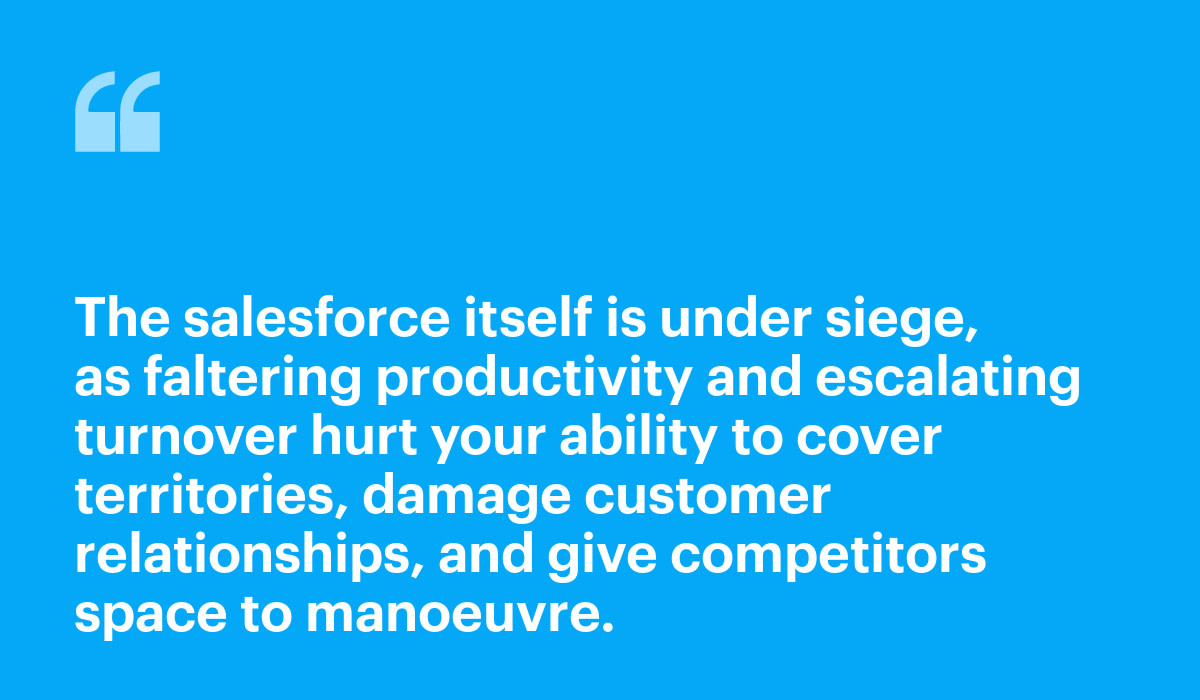Six Ways to Help Sales Leaders Protect Revenue Growth During Disruption
Revenue is an organisation’s lifeblood, so sales leaders carry a huge responsibility. Here are six strategies to protect revenue growth during disruption.

Revenue is the organization’s lifeblood, so sales leaders carry a huge responsibility. That responsibility is never heavier than during volatility—which the pandemic has hailed on a newly vast scale.
The customer ecosystem is more unstable than ever. Changing customer demand, expectations, and behaviours challenge sales organizations to rewire their operating model and processes. Global supply chain shocks fundamentally threaten the ability to deliver, risking long-term impact on customer relationships, loyalty, and lifetime value.
The salesforce itself is under siege, as faltering productivity and escalating turnover hurt your ability to cover territories, damage customer relationships, and give competitors space to maneuver.

Pummeled from all angles, how can sales leaders protect revenue growth despite uncertainty?
Play the long game
It’s crucial to look long-term in this mandate, towards sustainable future growth. Solving for today’s challenges can’t decimate tomorrow. Sales leaders will be evaluated not only on crucial near-time goals but also on where the organization is positioned in five (or even ten) years’ time.
Short-term measures that risk long-term hurt are fool’s gold. Gartner cautions against the risks of “short-term margin play” like slashing T&E expenditure and salesforce reduction. Instead, they warn, “Chief Sales Officers *(CSOs) should proactively develop a strategy for talent management that encourages managers to train in a way that […] maximizes retention of high-performing sellers.”
This is a critical point. The sales organization is at an inflection point, and although there are many facets of managing today’s changes there’s one foundational building block: your people.
Long-term sales success depends on having the right people in the right places, with the right skills and capabilities, and the right motivation and engagement to fuel productivity. Actions taken in isolation from this people perspective risk amplifying, not tackling, challenges.
Do you know your people?
To protect revenue during disruption, CSOs’ major question must be this: how close are you to your people? Do you have the people insights needed to embed resilience and agility into your team, to strengthen your culture, and to build the right skills for tomorrow?

When the answer is ‘yes’, there are six ways to help sales leadership insulate revenue growth from turbulence—and build a sales organization that’s better placed for tomorrow too.
Six strategies for revenue growth:
Optimize long-term salesforce performance
Decrease top performer turnover
Improve sales manager performance
Design a future-ready sales organization
Contextualize territory and quota decisions
Address compensation disruption
1. Optimize long-term salesforce performance
As customer expectations, behaviors, and working norms change, salespeople will need new skills to thrive. Identify what these skills look like and build them in your salesforce—both through recruitment and training—to protect future performance.
You must understand the DNA profile of your successful sales performers, to ensure you hire and train more people with those skills. Otherwise, the pressure of open territories and ever-increasing targets can lead to sub-optimal hiring, which can quickly become a negative cycle.
People insights make it easy to reverse-engineer the skills of top performers and put those insights into the hands of your on-the-ground managers, so they can make smarter recruitment decisions. People insights are also a springboard for fact-based, needs-based training and development decisions, making it simple to ensure your salesforce is growing in the right direction.
2. Decrease top performer turnover
Sales has always had some degree of turnover, often company-driven to maximise performance. That’s been increasing in recent years as companies’ skills needs change. But given shortages of top sales talent, this results in lots of movement of ‘average’ talent from role to role, further exacerbating the turnover problem. In this context, focussing on identifying and retaining your top performers is key.
Losing top salespeople doesn’t just incur recruitment costs and steal frontline managers away from revenue generation and people management. It also damages customer relationships and threatens territory coverage—risking millions in lost revenue.
With people insights, you can identify the top performers most at-risk of leaving, understand why, and target action to retain them. For example, First West Credit Union used people insights to discover where sales turnover was concentrated and unpick the root causes. By taking targeted action, they achieved $2.5M (~£1.9M) additional annual revenue within two years.
3. Improve sales manager performance
Sales managers have an enormous impact on the overall sales organization. Often a multi-million-pound impact, if you consider the revenue-generating potential of their team.
Gartner says overburdened sales managers can trigger double-digit declines in team quota attainment, for instance.
Empowering managers with relevant, actionable insights about their team means they can take fast action where it’s needed to resolve performance-hampering issues. Given the scale of upheaval right now, it’s especially important to insulate your sales force; to build resilience by safeguarding culture and morale.
Democratizing data like this engrains better daily people management—ultimately driving higher quota attainment and growing sales revenue.

4. Design a future-ready sales organization
The changes of the past couple of years are likely to have resounding after-effects in how, when, where, and why customers buy—and accordingly, the sales organizational model that’s most effective.
Matt Sunshine, Managing Partner for The Center for Sales Strategy and LeadG2, believes future sales organizations will need more specialization around stages of the sales process. And the pandemic has accelerated the shift towards remote work, which will likely have a knock-on impact on the structure of your sales organisation.
Only 11% of leaders feel well-equipped to build the organization of the future, Deloitte finds. Arming yourself to make better decisions here is critical.
Organisation design is another high impact area for people insights, giving you a data-driven, real-time picture of how work happens—and how sales get made—across your salesforce so you can optimise your organisation at pace with change to maximise revenue opportunities.
5. Contextualise territory and quota decisions
Realigning and rebalancing sales territories can be a valuable counter to disruption, and can “significantly increase sales, productivity, and profits”. But it can also have a big knock-on impact on your salesforce’s morale, motivation, performance, and turnover.
As The Journal of Personal Selling and Sales Management puts it, “although typically undertaken to improve aggregate sales force performance, the realignment of sales territories can be quite de-motivational to individual salespersons.”
Decisions like these shouldn’t happen in a vacuum, or you risk creating long-term problems that exacerbate revenue pressure. For salespeople, the alignment of company or solution with territory and compensation plan is what defines the sales opportunity. If this proposition isn’t strong and well-articulated, this is likely a big driver for turnover among your top performers.
People insights provide the crucial people context for territory and quota allocation, so you can make more informed decisions and plan appropriate mitigating action where needed.
6. Address compensation disruption
Disruption can hit salespeople where it hurts: their compensation. This has an impact on motivation, performance, and retention. It’s crucial to take hold of the problem before it escalates.
As Gartner recommend, sales leaders should “proactively manage sales compensation plans and quotas as a result of coronavirus-related disruptions”, to “back up a commitment to seller well-being”.
Top sales talent is expensive in all businesses. Faced with disruption there can be a tendency to economize here—but it’s a false economy. This can be extremely detrimental to sales performance, especially given the war for talent. It drives away your top talent to competitors and attracts sub-standard talent that doesn’t deliver. Minor savings on salaries and commission can easily drive multi-million on lost revenue delivery over two to three years.
Organizations harnessing compensation and workforce analytics are better positioned to make strategic decisions that make sense for both the bottom line and your people. Having sales compensation data available in a simple, single dashboard means you can develop a more informed compensation strategy that addresses disruption while managing costs.
Arm sales leaders with insights
Businesses that act now to shore-up the sales organization against unpredictability will protect revenue growth despite turbulence, positioning the organization strongly today and for years to come. That means arming sales leaders with the insights to understand and incisively solve their biggest people challenges.
A high-risk, high-reward function, the sales organization is an ideal use case for better decisions powered by better people insights. And the whole business stands to benefit. Here’s how you can enable your sales leaders to make better, more profitable decisions.
On the Outsmart blog, we write about workforce-related topics like what makes a good manager, how to reduce employee turnover, and reskilling employees. We also report on trending topics like ESG and EU CSRD requirements and preparing for a recession, and advise on HR best practices how to create a strategic compensation strategy, metrics every CHRO should track, and connecting people data to business data. But if you really want to know the bread and butter of Visier, read our post about the benefits of people analytics.



